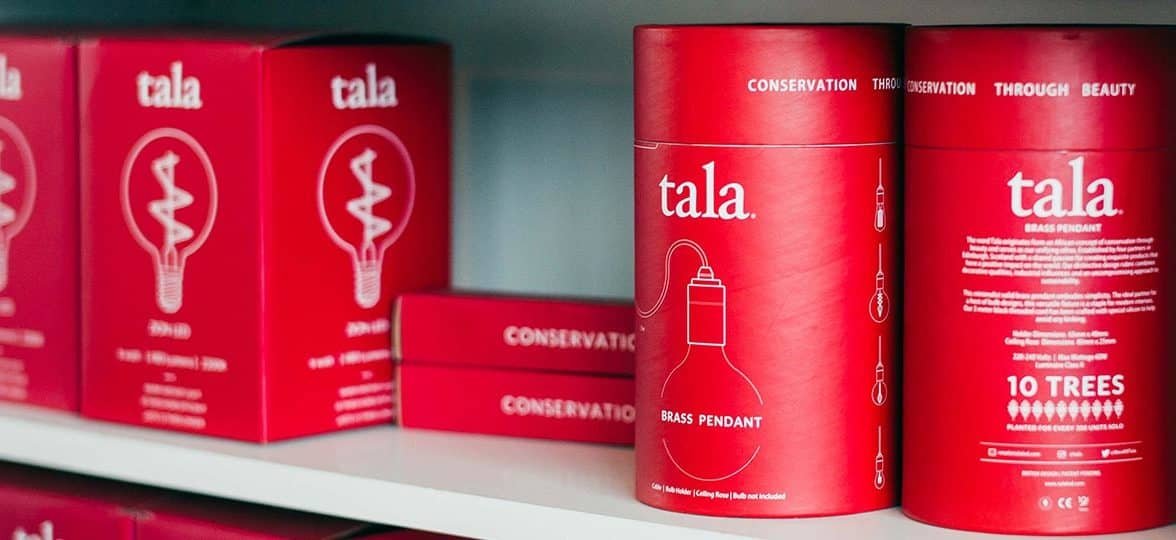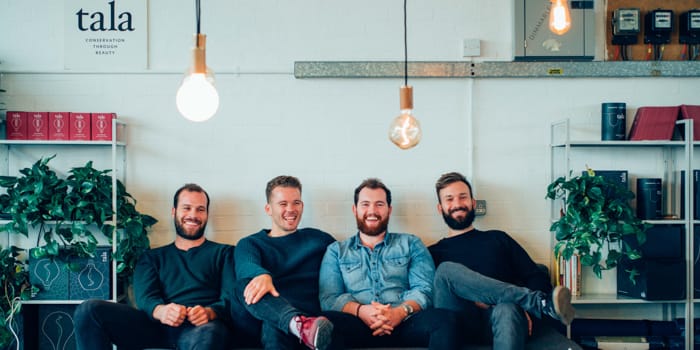Tala LED and the business of beautiful, sustainable lightbulbs

Many a great business starts with a great product that solves a dilemma. In answer to the escalating need for sustainable energy, Tala LED creates old-fashioned lighting with LED strips engulfed in elegant blown-glass bulbs for an energy-efficient – and gorgeous – alternative to standard lightbulbs.

We caught up with two of Tala’s four founders, William Symington and Ciaran Dawson, to chat about finding a niche and the importance of connecting with the right people.

Tell us about your “lightbulb” moment.
William: We wanted to develop a beautifully designed, low-carbon product that was accessible to the wider market. Lighting was the obvious choice as it is something everyone uses and the existing alternatives were simply not good enough.
Ciaran: The fundamental question we asked ourselves was, ‘why aren’t energy efficient technologies being adopted more quickly?’. We found that the industry had been dominated by a few extremely large organisations since its inception and this had led to the commoditization of lighting, which we saw as a flaw.
Sustainability and conservation seem to underpin your brand ethos. How do you walk the talk?
William: It is our ethos! We want to prove that you can have socially and environmentally friendly products that are commercially viable and not gimmicky. To this end, for every 200 bulbs we sell, we plant 10 trees.
Ciaran: The Heart of England is the charity that we are partnered with up in Stratford Upon Avon. We work with them to plant indigenous trees as part of their wider national reforestation program. Their ultimate goal is to plant 30 million trees so we’re going to play a big part in that mission.
What’s been the response to TALA?
William: Positive! People and retailers really get what we are about so we are very fortunate to be at a stage where we can handpick who we work with and really develop relationships with customers.
How do you make sure the right people notice and care about what you do?
Ciaran: This year, trade shows have been critical to our growth. We have presented in Germany, France, USA and the UK so far. Each show has its own personality and the demographics vary widely so we launched a broad campaign in order to meet as many people as possible before we start refining who exactly we want to work alongside.
William: Our products and ethos garnered much of our early stage recognition in themselves. Having said that, the design and brand team have been working hard on capitalising on this and bringing Tala to an even wider audience so we can plant even more trees!
Lighting isn’t exactly a niche market. How do you differ yourself from the competition?
William: There is nothing, and has never been anything, like our Voronoi range on the market before. Although many others have tried, no one can match our quality.
Ciaran: Our story, our people and our products.
How have your roles and day-to-day changed as the business has grown?
William: Having all started out as jacks of all trades and learning the basics across the whole business, we have now started to find our groove. Mine is in business development.
Ciaran: No day is the same so we have to be pretty flexible. We’ve all worked in every area of the company, but as we grow we have to oversee certain core functions so things don’t slip through the net.
Any advice for somebody wanting to start up their own business?
Ciaran: Do it – it’s simultaneously the most rewarding and most difficult thing you can choose to do. Even after a brutal week or month there is light at the end of the tunnel.
Better partnerships. A stronger culture. More lightbulb moments. Who doesn’t want those? That’s why networking isn’t just for events outside your company – it’s a crucial habit for people inside larger companies too. (So important, in fact, that MOO has a free infographic on this very subject.)
That’s why internal networking events are such a helpful tool. By connecting co-workers outside of your office’s traditional networks, you create more opportunities for teamwork and help employees get a handle on the bigger picture of what your company is all about. What’s not to love?
The internal networking event
An internal networking event is anything that brings employees closer together, from a casual lunch to a training program that helps your team learn new skills as a unit. It’s a way to help staff get on-board with company culture, and to get to know each other – which, in turn, helps teams perform better.
Your events don’t have to be formal. Volunteering, office parties, quarterly update gatherings, and even painting classes are all fun outings that help create connections. Your employees will get the benefits of socializing with people within the company, without the nerves that more formal networking events can bring.
The event prep checklist
Before the event takes place, hand out invitations on Notecards. The more advance notice you give, the more likely employees are to show up. Then, if you really want to boost RSVPs, throw in some customized Business Cards with the invite so your teams can swap contact info. After all, no networking event is complete without free stuff.
On the day of the event, make sure to distribute name tags on Stickers for handy lapel use. No one wants to be embarrassed that they forgot someone’s name immediately after meeting them. (Hey, it happens to the best of us!)
To help make the event a success, make a list of people or teams who should be collaborating. The event can even be geared towards having these teams getting to know one another to potentially boost interdepartmental collaboration on future projects. If there are any junior employees at the company, make sure to pair them off with mentors so they feel included in the festivities.
Last, if your shindig has a couple of different components, make Flyers available with the day’s agenda. Add in a menu card if you’re serving a meal or snacks. Nothing boost RSVPs like free food.
At its most basic level, internal networking ensures that people within your company know employees within other departments, and understand what they do. In other words, internal networking can spark those lightbulb moments between people from different departments. Plus, it increases the chances that people from all over the office will form closer relationships.
Greenery is a fresh, bright green that evokes the natural world – and it’s Pantone’s color of the year for 2017. But how can you use it in your design projects, or put it to work for your business?
Freshly cut grass, spirulina smoothies, our grandmas’ houseplants and Kermit memes – just some of the things that Pantone’s newly announced color of the year, Greenery, reminded our team of.
What is the color of the year?
Every year, Pantone, the global color authority, calls together a panel to select a color of the year. They review influences from the design world and beyond, looking to entertainment, art, popular travel destinations and even, in their own words, ‘new lifestyles and socio-economic conditions’.
It’s a choice intended to capture the mood of the time – and certainly, for anyone in the design world, it’s a steer that can influence projects of all kinds, from web builds to textiles.
But what does it mean for the rest of us? What might small business owners, keen crafters or companies going through a re-brand take from this announcement? We spoke to 3 of our in-house experts to find out what the color of the year might mean for you.
Designing with Greenery
Anna Ebubedike, Head of Brand Design
I love this color – it’s so uplifting. It’s a juicy, clean, healthy color. That’s why shades like Greenery are always popular choices for food companies. Equally, brands that want to show strong environmental credentials will use colors like this (ironically, quite often it’s the least environmentally friendly brands that make use of this association!).
Conversely, it’d be a bolder choice for a traditionally corporate business – sectors like financial services who often steer towards blues. So if you work in those areas and you’re looking to stand out (without losing the perception of being serious about business), you could do a lot worse than working with less predictable shades like this instead.
Printed products
Felix Ackermann, Senior Product Designer
It reminds me of house plants – succulents, those kinds of things. A kind of modern 70s feel. It’s a very calming, trustworthy color. I’ve been looking at using some similar shades to this alongside a neutral kraft brown in a product we’re developing, so I like it.
This kind of green is typically quite a hard color to replicate exactly in digital printing, particularly in fine detail or small text. So if you’re thinking of using it as a dominant color for your brand – printing all your business cards in this color, for example – you would do well to print a few test projects before you commit to be sure you’re happy with the end result.
The view from UX
Jaime Robb, Experience Designer
There’s a concept known as ego depletion that happens in cities and offices. Over the course of a day, being in contact with the sharp edges and dull colors of an urban landscape can wear out your mental resources and make you feel tired. Conversely, being in nature has the opposite effect – even looking at pictures of natural landscapes can restore our sense of ego and make us feel energised. So I see this kind of green as a very positive shade.
It’s a safe color. In user experience, this kind of color is always used for confirmation and approval. Green is go, green is good, green is yes. So in digital design, Greenery would obviously make a terrible choice for error messages. It would also make for pretty unreadable body copy too – so if you’re thinking of using it for any kind of text, tread carefully.
Does any of this matter to me?
Still not sure whether Greenery means anything to you? Don’t fret – as with any point of style, it’s not going to be for everyone. “Trends like this are a great way to gauge the bigger picture,” explained Anna.
“They’re a waypoint, not an instruction. But ultimately, any business – whether you’re a freelance photographer or part of a global corporation – has loads to gain from reviewing its choice of brand colors every so often. Now’s as good a time as any to take a fresh look.”
Leaf through our green designs.
In our collaboration with multimedia visual artist, Baron Von Fancy, we’ve found a way to bring a super-swish style to the oldest networking technology (and we have never loved our Business Cards more).
I always want my work to spark an interesting conversation.
This limited edition card pack stars Baron Von Fancy’s trademark bold text phrases, popping with a bright background. If you want to shake up your networking a touch, there’s no better way – bring a couple to your next conference and you won’t go unnoticed.
Gordon Stevenson, also known as Baron Von Fancy, is a multimedia artist who lives and works in New York City. On exploring our collaboration, he said: “MOO is the first group to really make business cards cool. I always want my work to spark an interesting conversation, and MOO reflects that vision. Together we want to showcase individual creativity in the world of networking.”We’re only printing 5,000 packs of these gorgeous cards – so if you want a bit of the Baron in your pocket, act fast!




















